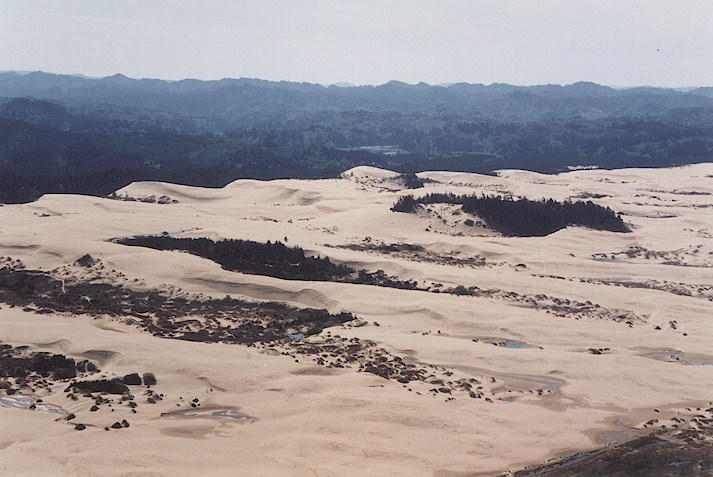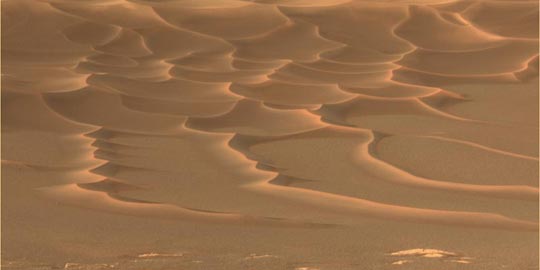Geotimes

Untitled Document

Travels in Geology
August 2004
Roving Oregon's dunes
 Last Friday, the Mars
Exploration Rover Opportunity took the closest images to date of dune fields
on the floor of a martian crater. Scientists hope to send the rover to study
the dunes, which are only a meter tall. But you don't need to leave Earth to
get some out-of-this-world glimpses of dunes. The United States contains many
remarkable dune fields including Great Sand Dunes, White Sands, Sleeping Bear
Dunes, Jockey's Ridge and Oregon Dunes. Oregon Dunes is the largest coastal
dune system in North America and visitors often see dune-buggies, rather than
rovers, wandering the landscape that looks as alien as the scenes from Mars.
Last Friday, the Mars
Exploration Rover Opportunity took the closest images to date of dune fields
on the floor of a martian crater. Scientists hope to send the rover to study
the dunes, which are only a meter tall. But you don't need to leave Earth to
get some out-of-this-world glimpses of dunes. The United States contains many
remarkable dune fields including Great Sand Dunes, White Sands, Sleeping Bear
Dunes, Jockey's Ridge and Oregon Dunes. Oregon Dunes is the largest coastal
dune system in North America and visitors often see dune-buggies, rather than
rovers, wandering the landscape that looks as alien as the scenes from Mars.
In this aerial photograph taken south
of the Winchester Bay area, in Oregon Dunes National Recreation Area, vegetation
grows in between transverse dunes. The introduction of non-native, invasive
plant species threatens to completely cover the dunes in some locations. Image
courtesy Darren Beckstrand and Errol Stock.
South of Florence and north of Coos Bay, Oregon Dunes National Recreation Area
stretches for 42 miles along Oregon's coast. The area contains dunes up to 600
feet high and a wide variety of dune features. Oregon Dunes is easily accessible
from Highway 101, part of the Pacific Coast Scenic Byway, and observant drivers
can catch glimpses of the dunes as they speed along.
The many rivers flowing westward from the Coast Range, which runs from southern
Alaska to California, delivered a large proportion of the sand that is now incorporated
into the dunes. Scientists, however, are uncertain about the mechanisms that
brought the sand together to form the dunes. One theory, says Darren Beckstrand,
a geologic consultant who wrote his master's thesis on the Oregon Dunes while
at Portland State University, is that retreating beach sand caused by sea-level
rise in the Holocene accumulated as it moved inland and formed the dunes. The
competing hypothesis, favored by Beckstrand, is that the sand was blown inland
from the continental shelf during periods of low sea level in the Pleistocene.
 The modern geologic features
of the dunes are as interesting as its history, says Gayle Gill, an information
assistant with the National Forest Service. In the winter, visitors can find
rare occurrences of yardangs — elongate, wind-sculpted ridges — among
the dunes. Intrepid hikers can also explore a field of heavily vegetated parabolic
dunes in the Winchester Bay area. The tallest dunes are located along the John
Dellenback trail, previously called the Umpqua dunes trail. For those who want
to explore the dunes but loathe the idea of slugging through soft sand to see
anything, a dune buggy is the perfect alternative.
The modern geologic features
of the dunes are as interesting as its history, says Gayle Gill, an information
assistant with the National Forest Service. In the winter, visitors can find
rare occurrences of yardangs — elongate, wind-sculpted ridges — among
the dunes. Intrepid hikers can also explore a field of heavily vegetated parabolic
dunes in the Winchester Bay area. The tallest dunes are located along the John
Dellenback trail, previously called the Umpqua dunes trail. For those who want
to explore the dunes but loathe the idea of slugging through soft sand to see
anything, a dune buggy is the perfect alternative.
NASA's Mars Exploration Rover Opportunity recently snapped this picture of small
dunes on the floor of Endurance Crater. Dunes are common features in the martian
landscape, and scientists hope to send the rovers to explore these features.
Dunes are also common sites across the United States, including on Oregon's
Coast. Image courtesy of NASA/JPL/Cornell.
Dune buggy/ATV rentals and guided trips are available at most of the surrounding
commercial hubs — Reedsport, North Bend and Florence. The Spinreel Campground
is the center of most off-road vehicle activity. About 50 percent of the dunes
are open to off-road traffic, but the vehicles are restricted to areas that
are not environmentally sensitive.
Sometimes, however, the reverse is true: The Forest Service has opened up vegetated
areas to off-road vehicles for ecological reasons, Beckstrand says. For example,
dune buggy traffic can help combat the invasion of non-native species of European
beach grass by keeping the grass populations in check. "The areas of open
sand have been rapidly decreasing over the last 30 to 40 years," he says.
If you are interested in visiting, you should consider planning a trip soon
while the dunes are still largely free of vegetation. August is the peak tourist
season, but Oregon's mild winters make the dunes enjoyable year-round, Gill
says. September through October, with small crowds and early fall temperatures,
may be the best time to visit. There is a day-use fee of $5 at most of the trailhead
parking lots, but compared to the $1 billion it cost NASA to be able to drive
Opportunity through the dunes on Mars, it is well worth it.
Jay Chapman
Geotimes Intern
Links:
Oregon
Dunes National Recreation Area
Darren
Beckstrand's Web site on Oregon Dunes
NASA website on Mars dunes
Back to top
Untitled Document

 Last Friday, the Mars
Exploration Rover Opportunity took the closest images to date of dune fields
on the floor of a martian crater. Scientists hope to send the rover to study
the dunes, which are only a meter tall. But you don't need to leave Earth to
get some out-of-this-world glimpses of dunes. The United States contains many
remarkable dune fields including Great Sand Dunes, White Sands, Sleeping Bear
Dunes, Jockey's Ridge and Oregon Dunes. Oregon Dunes is the largest coastal
dune system in North America and visitors often see dune-buggies, rather than
rovers, wandering the landscape that looks as alien as the scenes from Mars.
Last Friday, the Mars
Exploration Rover Opportunity took the closest images to date of dune fields
on the floor of a martian crater. Scientists hope to send the rover to study
the dunes, which are only a meter tall. But you don't need to leave Earth to
get some out-of-this-world glimpses of dunes. The United States contains many
remarkable dune fields including Great Sand Dunes, White Sands, Sleeping Bear
Dunes, Jockey's Ridge and Oregon Dunes. Oregon Dunes is the largest coastal
dune system in North America and visitors often see dune-buggies, rather than
rovers, wandering the landscape that looks as alien as the scenes from Mars.

 The modern geologic features
of the dunes are as interesting as its history, says Gayle Gill, an information
assistant with the National Forest Service. In the winter, visitors can find
rare occurrences of yardangs — elongate, wind-sculpted ridges — among
the dunes. Intrepid hikers can also explore a field of heavily vegetated parabolic
dunes in the Winchester Bay area. The tallest dunes are located along the John
Dellenback trail, previously called the Umpqua dunes trail. For those who want
to explore the dunes but loathe the idea of slugging through soft sand to see
anything, a dune buggy is the perfect alternative.
The modern geologic features
of the dunes are as interesting as its history, says Gayle Gill, an information
assistant with the National Forest Service. In the winter, visitors can find
rare occurrences of yardangs — elongate, wind-sculpted ridges — among
the dunes. Intrepid hikers can also explore a field of heavily vegetated parabolic
dunes in the Winchester Bay area. The tallest dunes are located along the John
Dellenback trail, previously called the Umpqua dunes trail. For those who want
to explore the dunes but loathe the idea of slugging through soft sand to see
anything, a dune buggy is the perfect alternative.